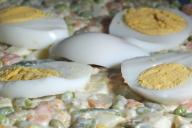Diet industry has made various low-fat foods extremely popular - they are marketed as healthier options for regular ones.
Meanwhile, low-fat doesn't mean good - moreover, our bodies need fat to stay strong and healthy.
Let's find out why you shouldn't buy low-fat products too often.

Added Sugars
When food manufacturers remove fat from products, they often add sugar to improve the taste.
While it may make low-fat foods more palatable, this extra sugar can have negative health effects.
Consuming too much added sugar is linked to issues like weight gain, heart problems, and an increased risk of diabetes.
Less Satisfying
Fat in foods helps you feel full and satisfied after eating.
When you opt for low-fat foods, you might not feel as full as you would with their full-fat counterparts.
This can lead to eating more to compensate for that feeling of fullness, potentially causing overeating and weight gain.
Missing Nutrients
Some vitamins, like A, D, E, and K, are fat-soluble, which means they require dietary fat for your body to absorb them properly.
If you're not consuming enough fat, you might not absorb these essential nutrients effectively, even if you're eating foods rich in these vitamins.
Processed Ingredients
To make up for the lost flavor and texture when fat is removed, low-fat foods often contain extra processed ingredients.
These can include thickeners, stabilizers, and artificial flavorings. These additives may not be as healthy for your body as naturally occurring fats.
Conclusion
In summary, while low-fat foods may seem like a healthier option, it's crucial to be mindful of the sugar content, additional processing, and the potential loss of essential nutrients.
Sometimes, foods with a moderate amount of natural fats, without added sugars, can be a wiser choice for your overall health and satisfaction.













